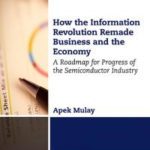
Copyright
Counterfeit electronics ¢‚¬œ A result of US Trade and Monetary Policies
Apek Mulay
Abstract
Counterfeit electronics have become a great concern for US semiconductor industry. Counterfeit ICs not only result in malfunctioning of modern electronics but also eat significant portions of profits of semiconductor companies. As engineers we focus on technical side of counterfeit mitigation methods. However, there is an important economic side of story which needs a fix in order to mitigate the introduction of counterfeits into supply chain. This article is based on my article ¢‚¬Å“A Failure Analysis of US economy¢‚¬ where I have analyzed the failure of economy (with semiconductor industry as an example) in terms of its unemployment, trade deficits, budget deficits, counterfeits and economic reforms. You can read the complete article at http://www.proutglobe.org/2012/12/a-failure-analysis-of-the-us-economy/
Introduction
Semiconductor mass production helps reduce the costs of electronics made available to consumers. At the same time, manufacturer/ producer profits due to mass production. For a healthy economy both producers and consumers have to prosper. A good ¢‚¬Ëœconsumer purchasing capacity¢‚¬„¢ acts as incentive for the producer to invest in research and development of better electronics that improve the quality of life. The biggest costs are involved in manufacturing semiconductors due to state-of-the-art tools and equipment costs and need to use the tools 24 x 7 to minimize the down time of tools.‚ The seeds of fabless semiconductor eco-system were sown when it was realized that by outsourcing semiconductor manufacturing to countries with lower value of currency, it was possible to minimize the costs related to manufacture. It was believed that this approach would give Fabless semiconductor companies extra revenue to invest in research and development of products.‚ Looking at the year-after-year profits of Fabless semiconductor companies like Qualcomm, Broadcom, etc. the IC manufacturing industries in US found it extremely difficult to compete due to higher labor costs of US as compared to Asian countries like Taiwan, China, etc. Hence, many companies in US who owned wafer fab, like AMD, Motorola, Infineon Technologies, etc.‚ decided to approach the fabless model by either spin-off of their manufacturing fab.
US Trade Policies
When it was observed by Multi-National Corporations (MNCs) that manufacturing costs can be decreased by moving away the manufacturing to China, it was also observed that by bringing back the cheaply manufactured goods back to US without any import duty would result in higher corporate profits. It was out of this logic that the concept of ¢‚¬Å“Free Trade¢‚¬ was born. Free trade implies no import duties imposed by a country on its imported goods.‚ While Free trade works great when trading with countries having nearly similar value of their monetary currencies, it results in high trade deficits when multinational corporations (MNCs) from a rich country make goods for cheap in another country with a significantly lower value of its currency. The MNCs in the United States prefer to manufacture things in low wage countries with cheap currencies, as it is highly profitable. However, in addition to increasing trade deficits, this practice also leads to massive job losses in the home country, especially when jobs are also outsourced.
If any country has a trade deficit (where imports are larger than exports), it leads to a fall in the country¢‚¬„¢s FOREX (FOREign eXchange) reserves (which eventually depreciates its currency). The value of a country¢‚¬„¢s currency is a deciding factor in the standard of living. Hence, a country cannot run year-over-year trade deficits if it wishes to maintain the standard of living of its citizens. Also, high trade deficits result in loss of FOREX reserves, which are important as they determine the buying power of the country¢‚¬„¢s currency.
Let us take an example of a country ¢‚¬ËœA¢‚¬„¢ where its population has sufficient purchasing power and can buy everything produced in the nation. But there are some products that are not produced at home and have to be imported from another country ¢‚¬ËœB¢‚¬„¢. Hence country ¢‚¬ËœA¢‚¬„¢ has to pay money [its currency] to buy country B¢‚¬„¢s goods. Either country ¢‚¬ËœA¢‚¬„¢ has to balance its trade by getting country ¢‚¬ËœB¢‚¬„¢ currency from a third country ¢‚¬ËœC¢‚¬„¢, or go on printing its own currency. But there is a limit that country ¢‚¬ËœB¢‚¬„¢ will accept country ¢‚¬ËœA¢‚¬s money. After that country ¢‚¬ËœA¢‚¬„¢ will have to produce the items within the country, causing huge inflation due to depreciated value of its currency resulting from excess money printing. It is possible to avoid trade deficits through balanced trade policies. Fair trade is more important than Free trade.
As a country, US can control over its trade policies but it cannot enforce its laws on its trading partners. Countries like china lacked effective supply chain management and have introduced counterfeit electronics into US. Since detection of counterfeit electronics has become increasingly expensive, MNCs in US improved supply chain by having preferred vendors in China.
In addition to nearly 600 billion dollars in trade deficit due to free trade policies, the counterfeit electronics from China entering into the U.S. supply chain have become a national security threat [11]. Initially, the United States manufactured all defense-related products at home. However, consumer electronics were being built in China due to its low cost of labor. As technology progressed to advanced transistor technology, it required a large investment from defense contractors, who work for profit, to manufacture semiconductor wafers in the United States. Hence, several defense contractors started to use Chinese built ICs for military weapons like missiles and machine guns. Along with the state-of-the-art infrastructure, the technical‚ know-how‚ to make advanced technology products has also been transferred to China.
US Monetary Policies
Since 1970s, US monetary policy has been that wages of workers should trail worker productivity so that it would increase corporate profits. Like imbalance in trade results in trade deficits, let us analyze how an imbalance in supply and demand results in budget deficits, consumer debt and National debt.
According to best-selling economist, Professor Ravi Batra, recessions and depressions occur when worker productivity keeps rising faster than the economy¢‚¬„¢s average real wage. He demonstrates that this happened in the 1920s, which were followed by a depression. The same thing also occurred during the 2000s and the world has been in The Great Recession since 2007. Batra argues that worker productivity is the main source of supply while wages are the main source of demand. If productivity rises faster than wages, then supply rises faster than demand. This results in overproduction and forces the manufacturer to fire workers. Producers are the suppliers of goods, and consumers generate the demand for these goods. Consumer demand, being dependent on wages, is sustainable only if the consumers as workers earn higher salaries. If the wages of consumers do not catch up with increased supply of goods, the supplier of goods is unable to sell all that he/she has manufactured. Hence, if consumer demand keeps on weakening, then the economy goes into a recession.
In that case to avoid a depression, the government has to step in and increase its own spending that makes up for the loss in demand due to lost wages of the laid off workers. The government may also cut tax rates to boost consumer demand. In either case, the budget deficit rises, and may rise very sharply if the wage-productivity gap and hence the supply-demand gap are very high. This is the main reason why the budget deficit rocketed after 2007, so much so that it almost tripled from about $500 billion in 2007 to $1.3 trillion in 2011.
Thomas Sharpe, a keynote speaker at ISTFA 2010, pointed out that China has been encouraging counterfeiting of electronics that are entering US supply chain. While US corporations try to enhance their profits by outsourcing manufacturing jobs to low wage countries like China, Chinese suppliers try to enhance their profits by inserting counterfeit chips into the US supply chain.
Balanced Economy to eliminate counterfeits
An economy is sustainable when it is able to balance its trade and budget. Being a global currency US has been able to balance for its trade and budget deficit by printing its currency. This process is not sustainable as USD would no longer be able to hold its status as global currency if it continues its current ¢‚¬ËœPrint on demand¢‚¬„¢ policy. Hence, it is important to perform crucial economic reforms that would eliminate trade deficit and budget deficit. In this process, counterfeiting of electronic components can also be eliminated.
If the United States had adopted fair trade instead of free trade, it would have imposed tariffs on the cheap electronics goods that are dumped into US by China. As people prefer to get the best value for their money, U.S. consumers would have preferred to buy U.S. made goods as tariffs would make them competitive with Chinese goods. This way if China tried to introduce counterfeits products into US supply chain, US consumers would never buy counterfeit Chinese goods. This way manufacturing jobs would could also be preserved. Simple math shows that by just eliminating the 600 billion dollar annual trade deficit would create 6 million jobs paying a $100,000 salary every year. This is a simple job creation strategy, as the country faces the highest unemployment rate since the Great Depression.
If you observe Fig. 2 above, real wages have failed to keep up with productivity since the 1970s. The productivity of American workers has been consistently increasing. However, the average household median income has not increased at the rate at which productivity has increased. The real hourly wages have remained fairly constant. The United States needs to reform its current economic model so that wages keep track with the productivity of workers [15].
Professor Batra argues that this can happen only in a free market system, where semiconductor companies are small and unable to control prices. Under this system, the majority of shares of US corporations would be owned by its employees rather than by a few investors on Wall Street. When workers become majority shareholders, they know that they are part owners of the company and will be fairly rewarded for hard work. By being highly productive, these workers would receive a fair share of corporate profits. The system would still preserve the incentive for growth because hard work would bring higher incomes.


Recent Comments